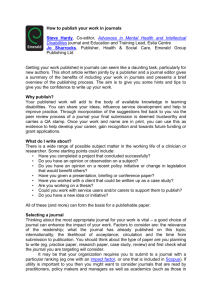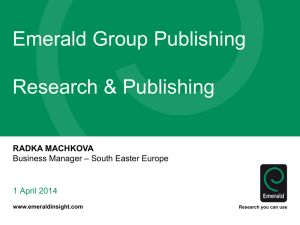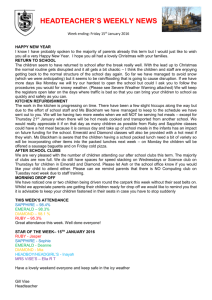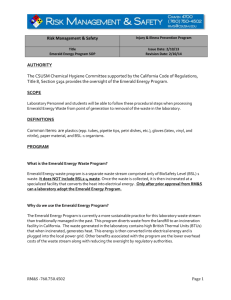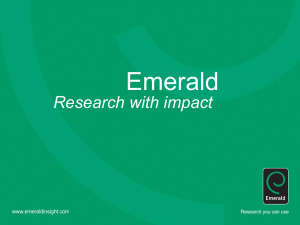duplication discovered.
advertisement
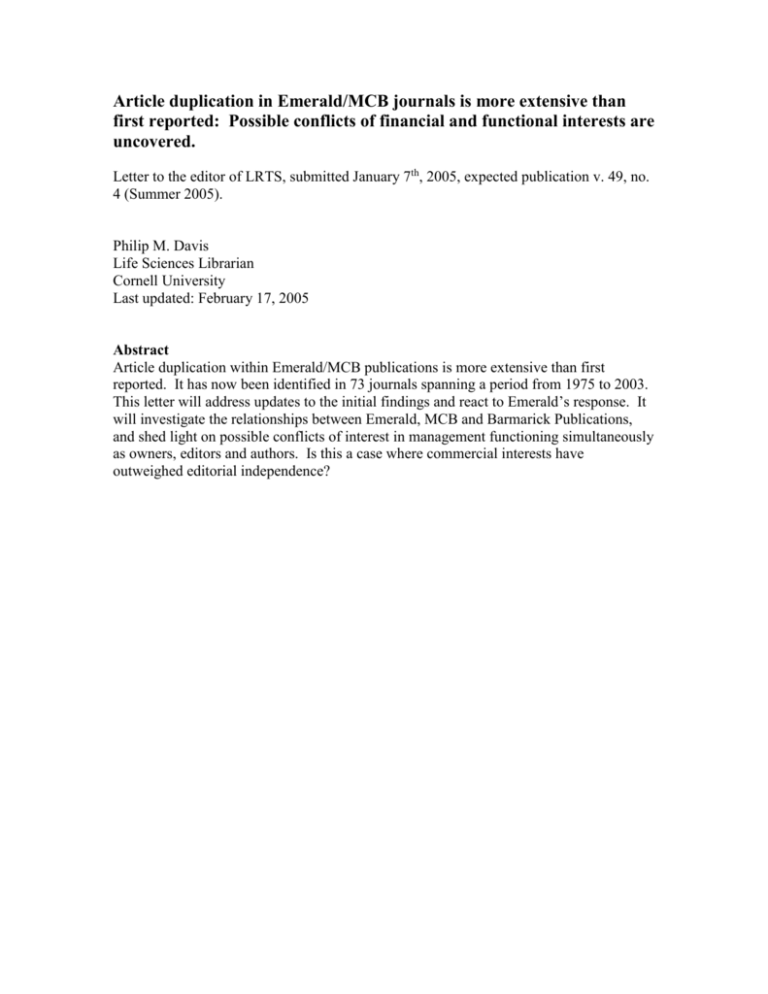
Article duplication in Emerald/MCB journals is more extensive than first reported: Possible conflicts of financial and functional interests are uncovered. Letter to the editor of LRTS, submitted January 7th, 2005, expected publication v. 49, no. 4 (Summer 2005). Philip M. Davis Life Sciences Librarian Cornell University Last updated: February 17, 2005 Abstract Article duplication within Emerald/MCB publications is more extensive than first reported. It has now been identified in 73 journals spanning a period from 1975 to 2003. This letter will address updates to the initial findings and react to Emerald’s response. It will investigate the relationships between Emerald, MCB and Barmarick Publications, and shed light on possible conflicts of interest in management functioning simultaneously as owners, editors and authors. Is this a case where commercial interests have outweighed editorial independence? Duration of Duplication and Emerald’s Response Covert article duplication practiced by Emerald/MCB was initially reported by the author as occurring between 1989 through 2003 [1]. Further investigation of MCB/Emerald print journals has identified article duplication going back to 1975 (Figure 1), indicating that this practice of covert article duplication took place over a period of almost thirty years. Contrary to the publisher’s response that “[article duplication] was done with journals that had a nil or negligible overlap of subscribers” [2], searches of library and union catalogs indicate significant overlap of subscribership. In addition, numerous instances of articles republished in the same journal were identified (Figure 2). Relationships between MCB, Emerald and Barmarick Publications The relationship between MCB, Emerald and Barmarick Publishers has been difficult to establish, and most attempts to contact the companies and their employees for details have gone unanswered. What is clear is that Emerald is the trading name of Emerald Group Publishing Limited, and was previously known as MCB University Press. MCB UP Group, however, continues to be the holding company for the Emerald Group. According to Gillian Crawford, Emerald’s Head of Corporate Communications, the company is currently owned by two of its directors, Dr. Keith Howard and Dr. Barrie O. Pettman [3]. In the publisher’s initial response to the findings [4], Emerald denied responsibility for article duplication in 2003, as the journal Equal Opportunities International was owned by another publisher -- Barmarick Publications. One of the owners of Barmarick is Dr. Barrie O. Pettman [5], who is also an owner, director and chairman of Emerald [3,6,7]. Dr. Pettman is also listed as the Associate Editor of Equal Opportunities International. In addition, this journal contains an Emerald logo prominently on its cover. The journal can be purchased directly from the Emerald website with fund transfers directly into the Emerald Group Publishing Limited bank account. Involvement of Management in Duplication According to Kathyryn Toledano, Emerald’s Director of Business Development, republishing an article without acknowledgment “was something that we did, but it wasn't a business practice” [2]. This statement doesn’t appear to corroborate with the facts: 1) article duplication was discovered in over 70 Emerald/MCB journals; 2) duplication reached 100% in some journals; 3) some editorial board members were unaware of this practice; and 4) some of the owners were also functioning as editors during the period of duplication. Based on the facts, it appears that top management may have facilitated and orchestrated article duplication as a business practice. For example, Dr. John Peters currently functions as Emerald’s Editorial Director, and was listed as a shareholder of Emerald Group Publishing Limited at the end of 2003 [5]. He is also the editor of the journal Management Decision and has served as the past editor of Internet Research and several other journals during periods of systematic article duplication. When he became editor of Internet Research in 1996 for example, nearly half of the articles (17 out of 36) articles published that year were duplicated in other MCB journals. Dr. Peters also republished his own articles. An article printed in the journal, Internet Research in 1995 was republished in Management Decision in 1996 (Figure 3.) Peters served as the editor of Management Decision at that time, with Dr. Barrie O. Pettman on its editorial advisory board. When one looks at the reprinted article, the author notes do not list Peters as the editor, but as the “Director of Red Swan Ltd.” In a second example, John Peters and Keith Howard (the current owner and director of Emerald) first published an article in a journal owned by the Bristol Business School. This article was later found in an Emerald journal with no acknowledgement of the original publication (Figure 4). What is also clear is that the owners did not follow the guidelines for their own journal, which clearly states in its notes for contributors that, "articles submitted to the journal should be original contributions and should not be under consideration for any other publication at the same time." Implications for Scholarly Communication At a time when academics have expressed great fears that commercial publishers are exploiting the scholarly publishing process, these Emerald/MCB findings study suggest that the trust between the academy and a commercial publisher may have been broken. To summarize the implications for the academy: 1) Academic institutions have discovered that they have been unknowingly purchasing duplicate material for nearly thirty years. 2) Multiple copies of academic articles have disrupted the record of publication, and confusion in the literature has arisen on which copy to cite. The duplication of articles may have also artificially increased the impact factor (and thus the prestige) of these journals. 3) The peer review process -- which is at the heart of scholarly communication – has been cast into doubt. Furthermore, conflicts of interest when individuals serve as owners, managers, editors and authors of academic journals lead us to question whether these individuals may not have been acting in the best interest of scholarly communication. Commercial interests have outweighed editorial independence. Questions to Emerald Emerald’s first public response [4] did not adequately address the most important issue: What specific changes has the company made to address these problems and to ensure that they will not reoccur? When academic publishing strives for transparency, why has it been so difficult to obtain information on the functions of Emerald/MCB directors? Does the company believe that these findings suggest conflict of interest, and if not, why not? Answering these questions might help Emerald regain the trust of the academic community. Figure 1. 1975 Duplication C. K. Walter and Bernard J. La Londe. “Development and tests of two stockout cost models.” International Journal of Physical Distribution 5, no. 3 (1975): 121-132. ———. “Development and tests of two stockout cost models.” Managerial Finance 3, no. 2 (1977): 85-96. Figure 2. Republishing in Same Journal Denman, A.R., E.P. Harris, M.R. Hermann, and P Phillips. "Auditing the Cost-Effectiveness of Radon Mitigation in the Workplace." Managerial Auditing Journal 14, no. 9 (1999): 461-68. ———. "Auditing the Cost-Effectiveness of Radon Mitigation in the Workplace." Managerial Auditing Journal 15, no. 4 (2000): 153-60. Elmuti, Dean, Judith Lehman, Brandon Harmon, Xiaoyan Lu, Andrea Pape, Ren Zhang, and Terad Zimmerle. "Inequality between Genders in the Executive Suite in Corporate America: Moral and Ethical Issues." Equal Opportunities International 22, no. 8 (2003): 1-19. ———. "Inequality between Genders in the Executive Suite in Corporate America: Moral and Ethical Issues." Equal Opportunities International 22, no. 2 (2003): 40-58. Greenley, Gordon E. "An Understanding of Marketing Strategy." European Journal of Marketing 18, no. 6 (1984): 90-103. ———. "An Understanding of Marketing Strategy." European Journal of Marketing 23, no. 8 (1989): 45-56. Figure 3. John Peters, Owner, Editorial Director, Editor, Author Peters, John. "The Hundred Years War Started Today: An Exploration of Electronic Peer Review." Internet Research 5, no. 4 (1995): 3-9. ———. "The Hundred Years War Started Today: An Exploration of Electronic Peer Review." Management Decision 34, no. 1 (1996): 54-59. Figure 4. Owner not following Emerald guidelines Peters, John and Keith Howard. "Looking for good research in management -- a publisher's case study." Bristol Business School Teaching and Research Review 4, Spring (2001). Accessed Dec 31, 2004, http://www.uwe.ac.uk/bbs/trr/ISSUE4/Is4-1_1.htm ———. "Looking for good research in management -- a publisher's case study." Management Decision 37, no. 7 (2001): 594-598. References: [1] Davis, Philip. The Ethics of Republishing: A Case Study of Emerald/MCB University Press Journals. Library Resources & Technical Services. v49 n2 (in press, Spring 2005). Online: http://people.cornell.edu/pages/pmd8/ [2] Scott Carlson. Publisher Ran Identical Articles in Multiple Journals Without Acknowledgment, Librarian Finds. Chronicle of Higher Education. Monday, November 22, 2004. Online: http://chronicle.com/free/2004/11/2004112205n.htm (cited Dec 08, 2004) [3] Gillian Crawford. Head of Corporate Communications, Emerald Group Publishing Limited. Personal correspondence. Dec 15, 2004. [4] Gillian Crawford. Dual Publication: Emerald's Response (Press Announcement). Nov 2004. Online: http://ariel.emeraldinsight.com/vl=3959651/cl=108/nw=1/rpsv/news/press/dual.htm (cited Dec 08, 2004) [5] Dr. Barrie O. Pettman. Personal correspondence. Dec 09, 2004. [6] MCB UP Limited. Directors and Officials. Dec 31, 2001. Available http://people.cornell.edu/pages/pmd8/MCB.tif [7] Emerald Group Publishing Limited (formally MCB UP Limited). Directors and Officials. Dec 31, 2003. Available http://people.cornell.edu/pages/pmd8/EGP.pdf

